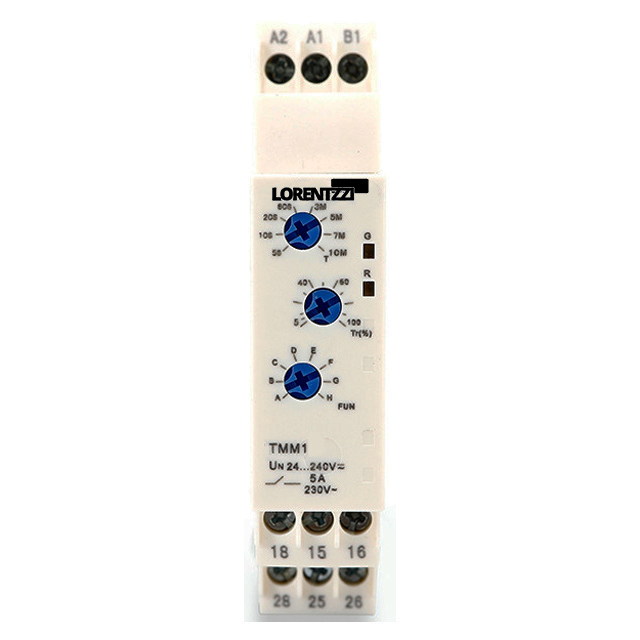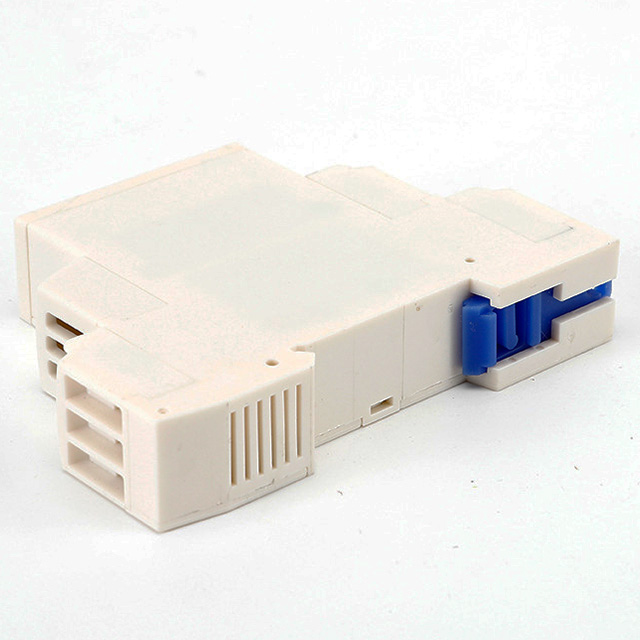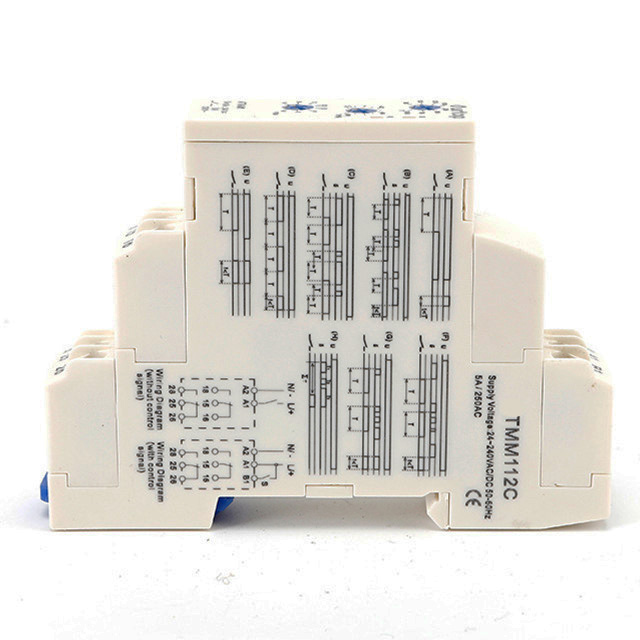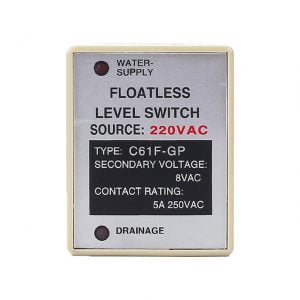What Is A Multifunction Time Delay Relay?
Multifunctional time delay relay is a device that can meet different usage scenarios through different functions.
Our TMM1 multifunctional timer relay has 10 working modes, namely,
- Mode A: On-delay relay,
- Mode B: Power-on interval (B mode),
- Mode C: Cycle delay OFF start (C mode),
- Mode D: Cycle delay ON start (D mode),
- Mode J: Pulse output (J mode).
These 5 working modes are based on power on, these functions are the same as our H3CR-A8 time delay relay.
The remaining 5 working modes work according to the external signal (S), which are
- Mode E: After the S signal is turned on, the delay starts when it is turned off,
- Mode F: Delay immediately after control signal is connected,
- Mode G: Control signal off-delay,
- Mode H: Control signal on-delay and off-delay,
- Mode I: Pulse conversion
We will introduce these 10 working modes in detail in the following section.
Description And Timing Charts Of This Programmable Timer Relay Mode
Mode A: When the product is powered on, it starts to delay according to the set time (T). When the delay time is up, the normally open contact closes immediately. When the power is disconnected, the normally open contact resets (normally open contact opens).
Mode B: When the product is powered on, the normally open contact closes immediately, and the product starts to delay according to the set time (T). When the delay time is up, the normally open contact opens. If the delay time is not up and the product is powered off, the normally open contact opens immediately.
Mode C: When the product is powered on, it starts to delay according to the set time (T). When the delay time is up, the normally open contact immediately closes and the product starts to delay again. After the delay reaches the set time (T), the normally open contact immediately resets and the product starts to delay again. This cycle continues until the product is powered off and the normally open contact opens.
Mode D: When the product power is turned on, the normally open contact immediately closes, and the product starts to delay according to the set time (T). When the delay time is up, the normally open contact opens, and the product starts to delay again. After the delay reaches the set time (T), the normally open contact immediately closes, and the product starts to delay again, and this cycle repeats until the product power is turned off and the normally open contact opens.
Mode J: When the product is powered on, it will immediately start delaying according to the set time (T). When the delay time is up, the normally open contact will close immediately. After 0.5 seconds, the normally open contact will open, generating a 0.5 second pulse.
Mode E: When the product power is turned on and the signal (S) is connected, the normally open contact closes immediately. After the signal is disconnected, the product starts to delay according to the set time (T). When the delay time is up, the normally open contact disconnects. During the delay process, the signal is connected again, the original delay is reset, and after the signal is disconnected, the delay starts again according to the set time (T).
Mode F:When the product power is turned on and the signal (S) is connected, the normally open contact closes immediately and the product starts to delay according to the set time (T). When the delay time is up, the normally open contact opens. During the delay process, the signal is connected and disconnected again, and the delay (T) remains unchanged and continues to delay.
Mode G: When the product power is turned on and the signal (S) is disconnected, the normally open contact closes immediately and the product starts to delay according to the set time (T). When the delay time is up, the normally open contact disconnects. During the delay process, the signal (S) is turned on and off again and the delay (T) remains unchanged and continues to delay.
Mode H: After the product power is turned on and the signal (S) is connected, the product immediately starts to delay according to the set time (T). When the delay time is up, the normally open contact immediately closes. When the signal (S) is disconnected, the product immediately starts to delay according to the set time (T). When the delay time is up, the normally open contact opens. During the delay process, if the signal (S) is connected or disconnected again, the delay (T) remains unchanged and continues to delay.
Mode I: When the product power is turned on and the signal (S) is turned on, the normally open contact immediately closes, and when the signal (S) is turned on again, the normally open contact opens. When the signal (S) is turned on, the normally open contact state changes.
Applications:
- Motor start sequence control,
- Stage lighting and sound sequence control,
- Stairway lighting turn-on time control after people come,
- Cooling fan control in the heating control system to prevent overheating.
- Other applications not mentioned here.
Speficications:
| Model | TMM1 |
| Working voltage | DC12V, DC24V, AC110V, AC220V, AC380V, AC/DC24V-240V |
| Function | 10 delay modes, please have a look at the above their desriptions |
| Rated power consumption | AC:≤1.5VA DC:≤1W |
| Delay range | 0.1 s~10 days |
| Setting accuracy | ≤5% |
| Repeat accuracy | ≤0.2% |
| Repeat power-on interval | ≤200ms |
| Electrical Life | 10^5 |
| Mechanical life | 10^6 |
| Altitude | ≤2000m |
| Contact configuration capacity(A) | 1NC/NO:8A; 2NC/NO, 2NC/NO, 1NC/NO+1instant NC/NO:5A |
| IP Class | IP20 |
| Class of pollution | Ⅲ |
| Use category | AC-15 |
| Contact capacity | Ue/leAC240V/1.5A,AC380V/0.95A |
| Output type | 1NC/NO;2NC/NO;1NC/NO+1 instant NC/NO |
| DIN rail Standard | (width)35mm(IEC/EN60715) |



















